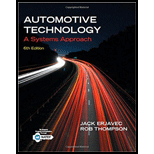
Bundle: Automotive Technology: A Systems Approach, 6th + Online ASE Technician Test Preparation -Automotive Bi-Lingual Series (A6 - Electricity & ... Preparation -Automotive Bi-Lingual Series (A1
6th Edition
ISBN: 9781337217767
Author: Jack Erjavec, Rob Thompson
Publisher: Cengage Learning
expand_more
expand_more
format_list_bulleted
Concept explainers
Textbook Question
Chapter 49, Problem 15RQ
While driving straight, a FWD car pulls to the right. The most likely cause is.
- more positive camber on the left front wheel compared to the right front wheel
Expert Solution & Answer
Trending nowThis is a popular solution!

Students have asked these similar questions
When checking the front end, which of the following are NOT cause for rejection?
Bearing cap is broken or missing or if there are any cracks or welded repairs to any components.
Front axle is bent or gear box mounting is loose, bolts are missing, or bolts or case are cracked.
All of the statements shown are cause for rejection.
The steering damper leaks, is loose, mount is cracked/ broken, or is missing or steering shaft coupler/universal is binding, frayed, or cracked.
Tech A says that camber changes as the suspension moves up and down. Tech B says that camber changes as the vehicle is loaded and the suspension sags under the weight. Who is correct
Hello, I am trying to study for a test and found this practice review but I'd like to be able to check my work. Can someone help answer some of these questions? Thank you
Chapter 49 Solutions
Bundle: Automotive Technology: A Systems Approach, 6th + Online ASE Technician Test Preparation -Automotive Bi-Lingual Series (A6 - Electricity & ... Preparation -Automotive Bi-Lingual Series (A1
Ch. 49 - Define camber.Ch. 49 - What tire wear pattern will result from excessive...Ch. 49 - What can be caused by excessive negative caster?Ch. 49 - Describe the difference between toe-in and...Ch. 49 - Describe thrust angle and why it is important foi...Ch. 49 - What can cause incorrect toe-out-on-turns?Ch. 49 - In what direction must the bottom of a tire and...Ch. 49 - What is scrub radius and why is it important?Ch. 49 - Prob. 9RQCh. 49 - Describe how caster adjustment may be used to com...
Ch. 49 - Which of the following is a good definition of...Ch. 49 - Prob. 12RQCh. 49 - A 3-degree difference in the SAI angle on each...Ch. 49 - Unequal SAI angles on the left and right sides of...Ch. 49 - While driving straight, a FWD car pulls to the...Ch. 49 - Technician A says that negative caster provides...Ch. 49 - Technician A says that the purpose of the steering...Ch. 49 - Technician A says that the presence of a thrust...Ch. 49 - Technician A says that camber changes as the...Ch. 49 - Technician A says that caster can be adjusted on...Ch. 49 - Technician A says that on FWD vehicles, the front...Ch. 49 - Technician A says that if caster at both wheels is...Ch. 49 - While discussing front-wheel caster: Technician A...Ch. 49 - While performing a prealignment inspection:...Ch. 49 - While performing a prealignment inspection:...
Knowledge Booster
Learn more about
Need a deep-dive on the concept behind this application? Look no further. Learn more about this topic, mechanical-engineering and related others by exploring similar questions and additional content below.Similar questions
- Unequal SAI angles on the left and right sides of the front suspension may cause. tread wear on the front tires brake pull during sudden stops ball joint wear steering wander while driving straight aheadarrow_forwardWhile performing a prealignment inspection: Technician A says that improper front-wheel bearing adjustment may affect wheel alignment angles. Technician B says that worn ball joints affect only the camber angle. Who is correct? Technician A only Technician B only Both A and B Neither A nor Barrow_forwardHello, I am trying to study for a test and found this practice review but I'd like to be able to check my work. Can someone help answer some of these questions? Thank youarrow_forward
- Can someone help me find the correct answer for these please?arrow_forwardTrue False? Camshaft straightness is checked using V-blocks and a feeler gauge?arrow_forwardAll of these statements about improper wheel balance are true except? a. Dynamic imbalance may cause wheel shimmy. b. Dynamic imbalance may cause steering pull in either direction. c. Static imbalance causes wheel tramp. d. Static imbalance causes rapid wear on suspension components.arrow_forward
- Tech A says that negative caster provides directional stability. Tech B says that positive caster results from excessive positive camber. Who is correctarrow_forwardThe typical RWD drive shaft rotates how many times faster than wheelsarrow_forwardtechnician a says that camber changes as the suspension moves up and down. technician b says that camber changes as the vehicle is loaded on the suspension sags under the weight. who is correct?arrow_forward
- 108) Technician A says that engine management malfunctions may be misinterpreted as transmission malfunction. Technician B says that imbalance in driveline components or wheels may be a likely cause of vibration. Which technician is correct? O Technician A O Technician B O Both technicians A and B O Neither technician A nor Barrow_forwardWhen adjusting a vehicle to counter the effect of road crown, what is the adjustment would you make-Adjust the left front wheel with slightly less positive caster-Adjust the right front wheel with slightly less positive caster-Adjust the right front wheel with slightly more positive camber-Adjust both front wheels with slight toe-outarrow_forwardTrue or False? The camshaft is always located in the engine block.arrow_forward
arrow_back_ios
SEE MORE QUESTIONS
arrow_forward_ios
Recommended textbooks for you
 Automotive Technology: A Systems Approach (MindTa...Mechanical EngineeringISBN:9781133612315Author:Jack Erjavec, Rob ThompsonPublisher:Cengage Learning
Automotive Technology: A Systems Approach (MindTa...Mechanical EngineeringISBN:9781133612315Author:Jack Erjavec, Rob ThompsonPublisher:Cengage Learning Automotive TechnologyMechanical EngineeringISBN:9781337794213Author:ERJAVEC, Jack.Publisher:Cengage,
Automotive TechnologyMechanical EngineeringISBN:9781337794213Author:ERJAVEC, Jack.Publisher:Cengage,

Automotive Technology: A Systems Approach (MindTa...
Mechanical Engineering
ISBN:9781133612315
Author:Jack Erjavec, Rob Thompson
Publisher:Cengage Learning

Automotive Technology
Mechanical Engineering
ISBN:9781337794213
Author:ERJAVEC, Jack.
Publisher:Cengage,
Mechanical Design (Machine Design) Clutches, Brakes and Flywheels Intro (S20 ME470 Class 15); Author: Professor Ted Diehl;https://www.youtube.com/watch?v=eMvbePrsT34;License: Standard Youtube License